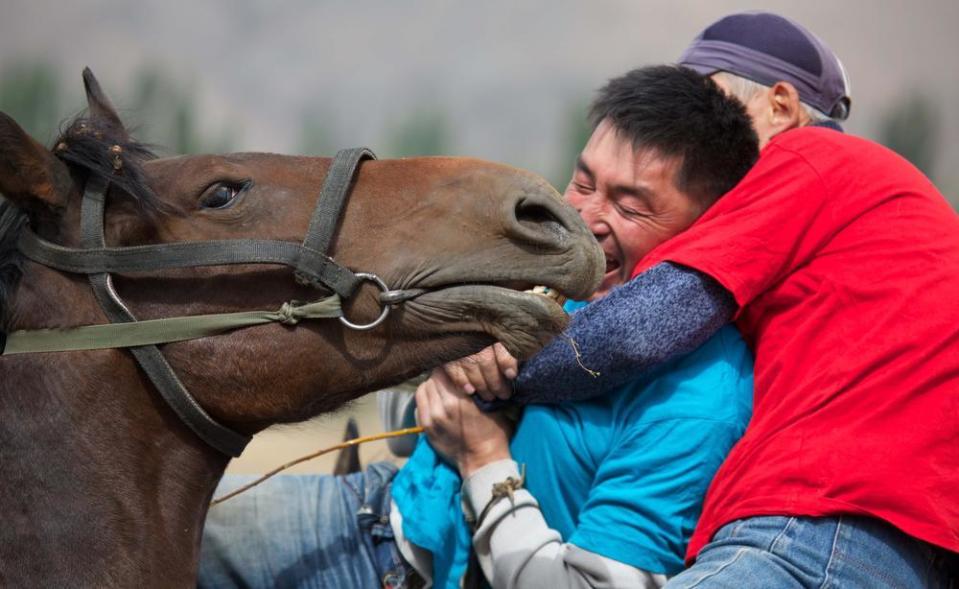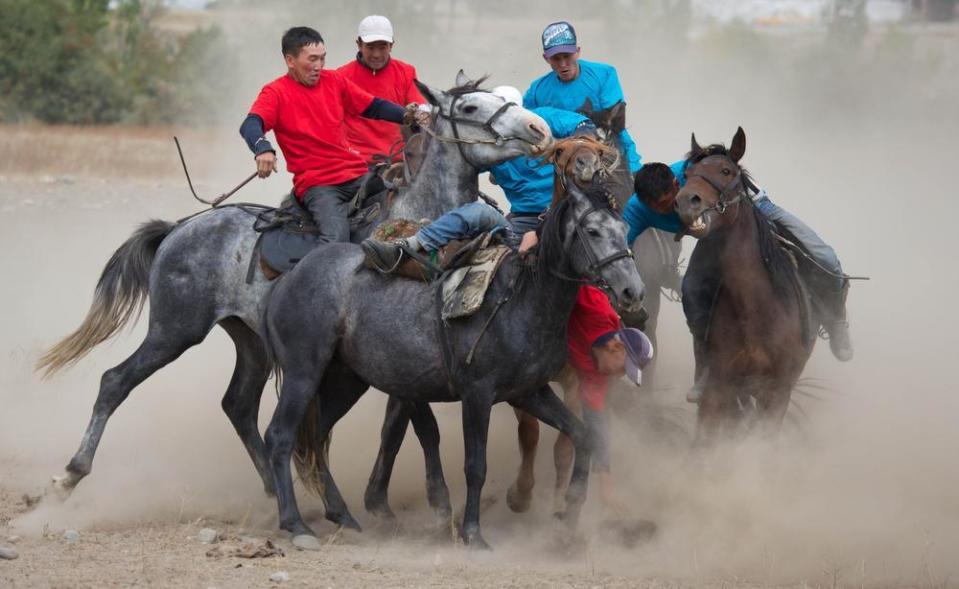Equine companions of Central Asia
Stephen Scourfield learns why the tough local horses are inseparable from the Kyrgyz nomadic heritage.
It is one of the best hours of the trip. I walk away from the little village of Bystrovka, towards the falling sun, with Kyrgyzstan’s Tian Shan Mountains flanking one side and the milky turquoise tumble of the glacial Chom Kemin river way off to the other.
I follow a dry, grey track. I like getting its dust on my boots.
The wheat has been harvested, the hay brought in, some stacked in bales that vary in colour from green to grey, and some still loaded on a turquoise truck that’s slowly dripping water from its radiator — a relic from the Soviet era in a country that has been independent since the collapse of the Soviet Union in 1991. Kyrgyzstan is more correctly and officially called the Kyrgyz Republic, and it sits on the western waist of Central Asia.
A woman is bent over a mound by furrows in the earth, dropping potatoes into a bucket. Wood is already being stacked for winter.
The sun is in my face and though it has been warm today, there’s a bite in the breeze coming down the valley.
Summer is from May to September, when the days might be mid-20C such as today, but imagine the -6C in the lowlands in winter and -26C or more in the highlands. Imagine the real cold in this valley, for in northern parts of Kyrgyzstan, freezing winds blow from Siberia and the Arctic Circle even in early spring.
To me there is the vague, slightly scary hint of that even now, in what is surely a summer evening to these Kyrgyz villagers. The breath of this warning rustles the leaves of the poplar trees, and ruffles the feathers of three solitary snipe when I disturb them and they fly flat, mottled and camouflaged against earth that sees very little rainfall.
A shepherd in a dark green jacket and cap squats way off by his sheep. A blonde, soft-nosed brown cow turns to look with big, black, slightly mournful eyes.
But it is the Kyrgyz horses that I have walked up this valley to see, and I hunker down by a chestnut gelding, his mane tossed by wind. He’s tethered by hemp rope, grazing on greens, munching in a happy circular motion.
He puffs most of the air from his lungs in one warm blast that flares his nostrils, and I return the greeting. I quietly cluck the tongue on the roof of my mouth, and he snuffles again.
The Kyrgyz were raising horses on the steppes some 2000 years before the birth of Christ. And they are extraordinary horses — tough, nimble animals adapted to the tough mountain climate. They are known for their endurance — bred to cover vast distances with the Kyrgyz’s wandering herds.
For the Kyrgyz tribes are of the nomadic Turkic people who have roamed over Central Asia for thousands of years.
As September brings the first cool warning of winter, I watch Kyrgyz horsemen bringing cattle down from the Oguz Glacier valley, near Jeti Oguz — which is near Karakol, high up and out in the east of Kyrgyzstan. They drag them through the fast, milky Jeti Oguz river, which streams from the glacier at the top of the valley, and drive their herd of horses down through the Jeti Oguz Gorge’s Valley of Flowers.
Horses were historically both a necessity and a matter of pride. In ancient tradition, it was felt that a man without a horse was not a man. It was considered honourable to die on a horse on a journey.
A man’s standing and dignity were set by the condition of his horse and the beauty of his harness.
A complete harness meant a complete man and embodied all aspects of the nomadic culture — hunter, warrior, cattle man. A harness is still an object of great pride for Kyrgyz people.
It was traditionally believed that even if a Kyrgyz hadn’t got a horse, they must have a saddle. It was easy and common to borrow a horse but a saddle would be loaned grudgingly.
Saddles cost nomads perhaps twice the price of a horse but would be used for maybe 150 years.
And so the horse is ingrained and inseparable from the Kyrgyz nomadic heritage.
It is said that only in death does a Kyrgyz stop roaming. And then, a permanent home is made —such as those here, up this dusty track, where yurt frames have been placed over a burial site.
An ancient proverb says that horses are “the wings of the Kyrgyz”, and horsemanship is prized in Kyrgyzstan.
Horse races may be up to 30km long and buzkashi, in which two mounted teams compete over a goat carcass, trying to drop it on a goal is a strong part of Kyrgyz culture.
But the Kyrgyz horse is also a work companion, a friend for life (children often learn to ride at the same time as they are learning to walk) and a mount for eagle hunters. It is said that a good horse, man and eagle can catch perhaps more than 50 foxes, 10 badgers and a handful of wolves in the four- month hunting season.
In the Jeti Oguz Gorge, near Karakol in east Kyrgyzstan, eagle hunter Kadyrdin Shermanbetov has a two-year-old eagle on his gloved fist, and a six-year-old bird tethered to the towbar of his VW Polo (which has an eagle, with wings outstretched drawn in the dust on the rear window).
Like most, he learned to hunt with eagles from his father and grandfather, and, while the fare today is a rabbit, he hopes to teach the older eagle to hunt wolves.
The horse is also a source of a much-respected food.
There is the mare’s milk that is fermented for the national drink kymyz — though Ulan Ermekov, who is showing me around Kyrgyzstan, warns that when mare’s milk is drunk in spring, at the start of the warm season, there can be a “stomach revolution” until one becomes used once again to it.
And the Kyrgyz horse provides meat — a source of protein but also something much respected and intrinsic to big celebrations and funerals.
There is still a mystique to the Kyrgyz horse.
Another ancient Kyrgyz saying is: “A brilliant man suited in armour lives in a woman’s heart; a saddled fiery horse lives in a man’s heart.”
I walk on through the other horses tethered in the valley, and the foals tethered to their mothers by need.
I like getting dust on my boots; this grey, desiccating Kyrgyz dust.
And now, the next day, it is pluming in the air, blowing away from my horse’s hooves, as I join others in a Travel Directors group travelling, over 28 days, the Five Stans of Kazakhstan, Kyrgyzstan, Tajikistan, Uzbekistan and Turkmenistan, to ride horses from the village of Bystrovka.
We follow local horseman Aliev Nurdiu out past the cut pastures of the Chom Kemin valley and along one side of the mountains before dropping down again, to the open space where these Kyrgyz riders meet to compete and show their skills.
Tony Evans, who conceived, researched and is leading the Five Stans, has arranged for them to do just that for us.
Horsemen come galloping in to join, and some sit around companionably near one another on their horses. They have the look of men who are tough, competitive, good-humoured and uncompromising.
First they race along, slinging themselves along one side of the saddle, and try to grab small flags stuck in the ground.
Then they wrestle, one on one, by locking right hands and trying to pull one another off the horses they straddle.
Then the main game begins. Buzkashi. A freshly killed black goat, apparently weighing about 20kg, is picked up by a rider and carried, usually hooked under one leg, toward the opposing goal, until someone manages to hoist it from him, or it is dropped and picked up again. The two teams race and wheel in clouds of dust until, eventually, the red team beats the turquoise team four to two.
The tenderised goat is then taken by the horsemen to be cooked and shared.
Horses have been at the heart of Kyrgyz life for perhaps more than 2500 years and today, in Bystrovka, that continues.
Yet another old saying commands: “If you are given only one day’s life, spend half of it in the saddle.”
And I am grateful to have spent half a day in the saddle of a Kyrgyz horse.
Stephen Scourfield was a guest of Travel Directors and China Southern Airways.
FACT FILE
Travel Directors’ The Five Stans tour visits Kazakhstan, Kyrgyzstan, Tajikistan, Uzbekistan and Turkmenistan. traveldirectors.com.au, 137 Cambridge Street,Leederville, 1300 856 661 and 9242 4200.
China Southern Airways flies direct between Perth and Guangzhou and connects with 190 destinations in 40 countries, offering full service flying at low-cost prices. csair.com.au or 1300 889 628 during business hours.





